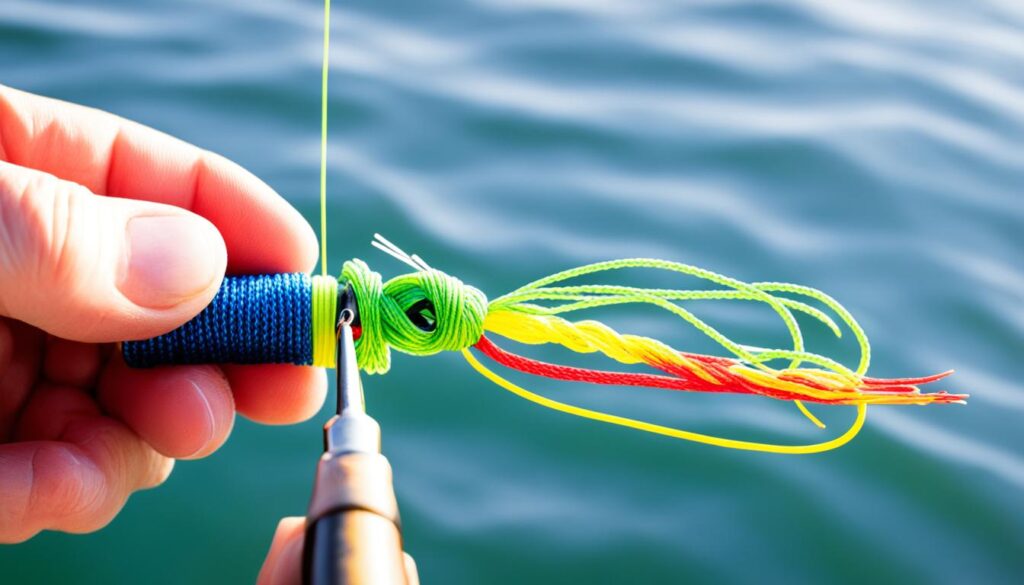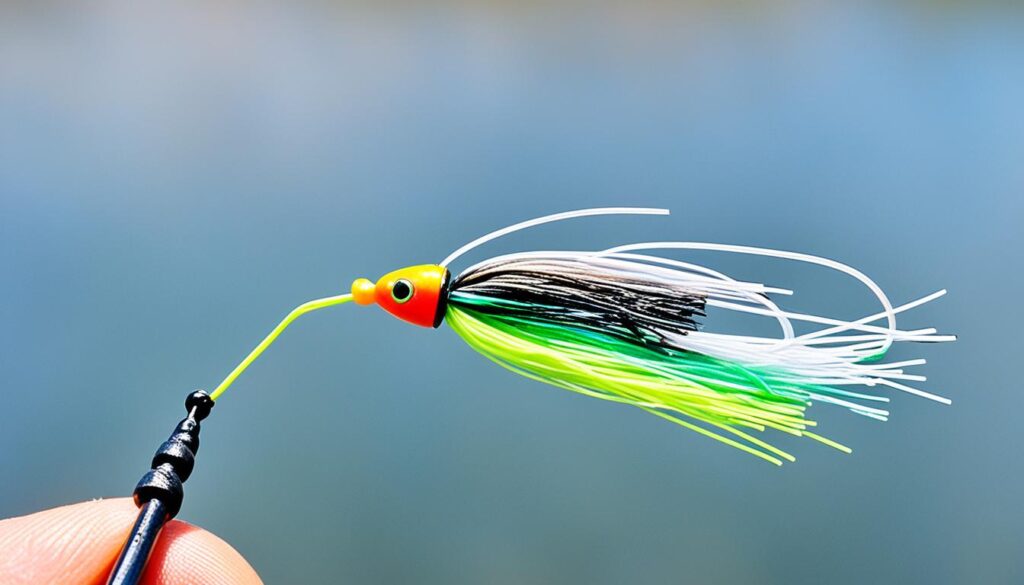Are you an angler keen on bettering your topwater lure fishing? Learning a simple loop knot is critical. This knot is excellent for baits without split rings. It lets them move side to side well and walk enticingly.
The Rapala Knot is a top choice for bigger lures. It’s known for its easy loop size adjustment. To tie it, begin with a half knot 3 inches from the tag end. Guide the tag end through the eyelet and the half hitch. Wrap the line around itself 3-5 times and pull the tag end back through the half hitch. Slowly tighten the wraps to secure the knot. When you pass the line through the half hitch, please keep the loop small. It will naturally expand a bit as you tighten the knot.
Opting for a loop knot with topwaters has multiple perks. Firstly, it adds action to your lure. This makes small plastics appear lively and irresistible to fish. Secondly, the loop knot’s freedom of movement lets your lure walk, pivot, and move sideways. This can make your lure more effective at drawing in fish.
Angler’s Essentials:
- Loop knots are essential for anglers who want their topwater baits to have more action.
- The Rapala Knot is a popular loop knot for larger lures.
- Loop knots allow for increased lure movement and attract fish with enticing action.
- The loop size in a simple loop knot can be adjusted by making the initial loop small before tightening the knot.
- Using a loop knot reduces fish loss risk compared to a split ring.
Advantages of Using a Loop Knot for Topwaters
An ideal way to fish with topwater lures is to use a loop knot. It gives your lure better movement, making it look more real to fish. The loop knot also lets your lure act like a real creature, attracting fish better.
Finding the right loop knot is critical for successful fishing. You need one that’s easy to do and reliable. The simple loop knot is a top pick for fishermen. With practice, you can tie it quickly and keep the loop size right.
Having enough space to work is essential when tying a loop knot. This is especially true for big lures with many hooks. Making sure you have room helps you tie the knot well. It’s also better to tie your lure directly to it, not use a split ring. This improves the lure’s movement and avoids losing fish.
Key Advantages:
- Enhanced lure action
- Increased likelihood of attracting fish
- Flexible and versatile movement for topwaters
- Quick and easy knot tying
- Reduced risk of fish loss
Why Direct Tying Is Preferred:
Direct tying your lure makes it move better in the water. This maximizes its ability to attract fish. By not using a split ring, you simplify your fishing setup. This leads to a smoother fishing trip.
Expert Tip:
You can try tying the loop knot with different fishing lines to get the hang of it. This practice will make you more skilled with the knot, making your fishing more effective.
Summary:
A loop knot for topwater lures has many benefits. It makes the lure move better, looks more natural, and attracts fish effectively. The key is to pick a loop knot that’s quick and easy to tie. Tying your lure directly with a loop knot is better than using a ring. This way, your lure moves better, and you have a lower chance of losing fish. With a little training, you can be great at tying loop knots. This will improve your fishing experience.
Step-by-Step Guide to Tying a Simple Loop Knot
Tying a simple loop knot is vital for both new and skilled anglers. This knot is great for topwater fishing, making your lure move more. This attracts more fish. Follow these steps to learn the simple loop knot:
- Start by threading the line through the lure’s eye. Make sure you have enough lines to tie the knot.
- Then, form a loop by bending the tag end back with your hand or fingers. This loop sets the final loop size.
- Twist the doubled line twice to make a loop inside the loop.
- Put the lure through the small loop you formed.
- Slide the knot towards the lure’s eye. Keep the loop size under control.
- Now, could you tighten the knot? Hold the overhand knot and the mainline and pull the tag end gently. Avoid making the loop too big by mistake.
- After securing the knot, cut the extra line next to the knot with scissors or a cutter.
Benefits of the Simple Loop Knot
The simple loop knot is great for topwater lures. It’s easy for beginners. This knot improves how the lure moves, making it better for catching fish. No matter your skill level, you need to know this knot for fishing.
Tips for Tying the Simple Loop Knot
- Practice tying the simple loop knot before you fish. Knowing the knot well helps you do it fast and right.
- Change the loop size by moving the overhand knot closer or farther from the lure’s eye.
- When tightening the knot, make sure the loop is the right size. Careful not to make it too big by accident.
- Always cut the extra line very close to the knot. This stops it from snagging the lure.
Follow these steps to learn how to tie a simple loop knot well and fast. This knot boosts your lure’s action. It will lead to more fishing success.
Benefits of Using the Non-Slip Mono Loop Knot
The non-slip mono loop knot is excellent for anglers. It’s easy to learn and very strong. It’s perfect for attaching lures or flies that move without a split ring.
This knot lets your lures and flies move freely. They can wiggle and turn more easily. This means more fish might find your bait attractive.
The knot stays put, even in tough fishing conditions. It’s good for lines up to about 40 pounds. This makes it handy for a wide range of fishing needs.
You start with a simple overhandoop knot to tie the non-slip mono l knot. Leave a tag end that’s 5 to 6 inches long. Feed the tag end through the lure or hook’s eye, then back through the knot. Afterward, wrap the tag end around the line a few times and thread it back through the knot. Tighten the knot carefully without changing the loop’s size. Cut off the extra tag end, and you’re done.
Using this knot will make your fishing more successful. Your bait will move better, the knot is dependable, and more fish might be tempted to bite. You can try it out and see the difference it can make in your fishing.

The non-slip mono loop knot at a glance:
| Advantages | Instructions |
|---|---|
| Easy to learn | Tie a simple overhand knot |
| Strong and reliable | Thread tag end through lure eye and overhand knot |
| Enhanced lure action | Wrap tag end around line/leader, pass it back through overhand knot |
| Suitable for line diameters up to 40 pounds | Slowly cinch knot tight, trim tag end |
Conclusion
Adding loop knots to your fishing skills can up your game with topwater baits. They are helpful for both new anglers and pros. The simple loop and non-slip mono loop knots make your bait move better. They are easy to learn by following the steps. You’ll tie them securely in no time.
The simple loop knot is easy to tie and control. It lets your bait move in a lifelike way, catching the eye of fish. On the flip side, the non-slip mono loop knot is strong and moves freely. This knot is perfect for lures that don’t have a split ring. It adds more action to your bait, enticing even the pickiest fish.
Targeting fish that jump at surface baits? Learn these essential loop knots for success. Keep practicing until they’re second nature. With these knots, you’ll confidently use topwater baits. And you’ll catch more fish, taking your fishing up a notch. It’s time to make the most of your fishing trips!
FAQ
What are loop knots, and why are they important for fishing with topwater?
Loop knots are key for fishing with topwaters. They help lures without split rings move better. This makes the bait walk more effectively, attracting more fish.
What is the best loop knot for larger lures?
The Rapala Knot is great for big lures. It gives good control over loop size. This means lures move better, and you’re less likely to lose a catch.
How do you tie a simple loop knot?
Tying a simple loop knot is easy. First, make a half knot about 3 inches from the tag end. Next, pass the tag end through the lure’s eyelet and the half hitch. Wrap the line 3-5 times, then pass the tag end through the half hitch. Pull it tight to secure the knot.
What are the advantages of using a loop knot for topwaters?
A loop knot enhances topwater fishing in several ways. It makes lures move more and look real. This gives them the freedom to walk, pivot, and move better, which attracts more fish.
What is the best loop knot for anglers?
The top loop knot is fast and easy to tie correctly every time. Many anglers favor the simple loop knot for this reason.
How do you tie a simple loop knot for beginners?
To tie a simple loop knot, pass the line through the lure’s eye. Then, make a loop with the tag end and twist it twice. Pull the lure through the loop. Tighten the knot close to the lure’s eye.
What is the non-slip mono loop knot?
The non-slip mono loop knot is easy to learn and strong. It’s great for lures that swim, especially if they don’t have a split ring.
How do you tie the non-slip mono loop knot?
To tie this knot, start with an overhand knot in the line. Insert the tag end through the eye and back through the knot. Wrap the tag end around the line 4-5 times, then pass it through the knot again. Tighten the knot carefully without changing the loop’s size. Cut off the tag end close to the knot.
Are loop knots useful for anglers of all levels?
Loop knots are handy for anyone who wants to do better at topwater fishing. They add more movement to the lure. This benefits both new and expert anglers.
